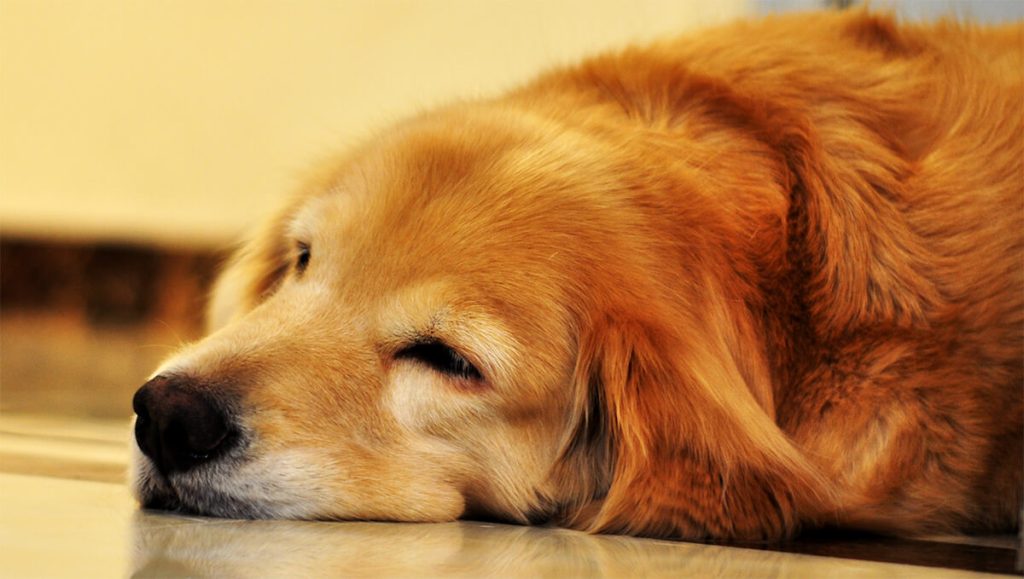Table of Contents
ToggleYour older dog wakes up in the middle of the night and is unable to fall back asleep. You may have read numerous articles and still been unable to figure out how to help older dog sleep through the night. In this blog, we get right to the point, identify the dog’s issue, and then use home remedies to help the dog fall asleep again quickly.
I’m not going to summarize general phrases like “5 reasons” or “9 tips” for you because they’re superficial and useless. Every older dog has its own set of issues and all we have to do is look at what the dog’s symptoms are and then follow the picture to find the cause and assist the dog in resolving the issue.
The basics of sleep in senior dogs
Before we begin to investigate the causes, let’s first understand some basics:
Exercise is not the key
An elderly dog requires more than 14 hours of sleep per day, and they can sleep well at night even if they do not exercise much during the day. As a result, the old dog’s night sleep has little to do with the amount of exercise she gets during the day.
Unbearable physical lesions may be to blame
The old dog’s sleep cycle usually alternates between 15 minutes of sleep and 5 minutes of waking up, and if the 5 minutes of waking up are not uncomfortable, she will quickly move on to the next sleep cycle. On the contrary, old dogs never stay awake in the middle of the night just out of boredom. Once if she wakes up and is unable to fall back asleep, it means there are something serious that making her unbearable and unable to go back to sleep again.
Medical history is a factor that cannot be ignored
Each old dog has a distinct medical history. When your old pal is unable to sleep, the first thing you should do is review her past medical history, which includes but not limited to CHD, nephritis, food/drug allergies, skin diseases, and so on, and then look for symptoms that are related to these past medical histories.
If you notice symptoms that are strongly suggestive of a previous medical history, it is best to contact your vet as soon as possible for a consultation. If you are unable to contact your vet, you can try the previous prescription to administer medication and treatment to see if the dog can gradually relax and return to sleep.
Now, let’s take a look at the most common behaviors of old dogs who don’t sleep at night.
Part I:Walking back and forth: the most common symptom
Pacing back and forth is the most common symptom of an elderly dog who is unable to sleep at night. Please keep in mind that pacing back and forth implies a number of different conditions that cannot be generalized. To make a complete diagnosis, we must combine the dog’s other symptoms. The good news is that you will be able to quickly diagnose the dog if you follow my instructions.
There are numerous reasons for walking back and forth. I’ll go over some of the most common reasons here. You can skip ahead to the causes you’re interested by clicking the content table at the top of this blog post.
Walking back and forth, boing from time to time with an anxious pace and rapid wheezing
The first thing to suspect is a Urinary Tract Infection, which is the most common disease in senior dogs. Please keep a close eye on the dog if any of the following symptoms appear.
- Frequent licking of the urethral orifice.
- The amount of drinking water consumed is significantly greater than usual.
- When dogs pee, they show signs of pain.
- The urine of the dog is cloudy or even bloody.
If your dog exhibits most of the symptoms listed above, she is most likely suffering from a urinary tract infection.
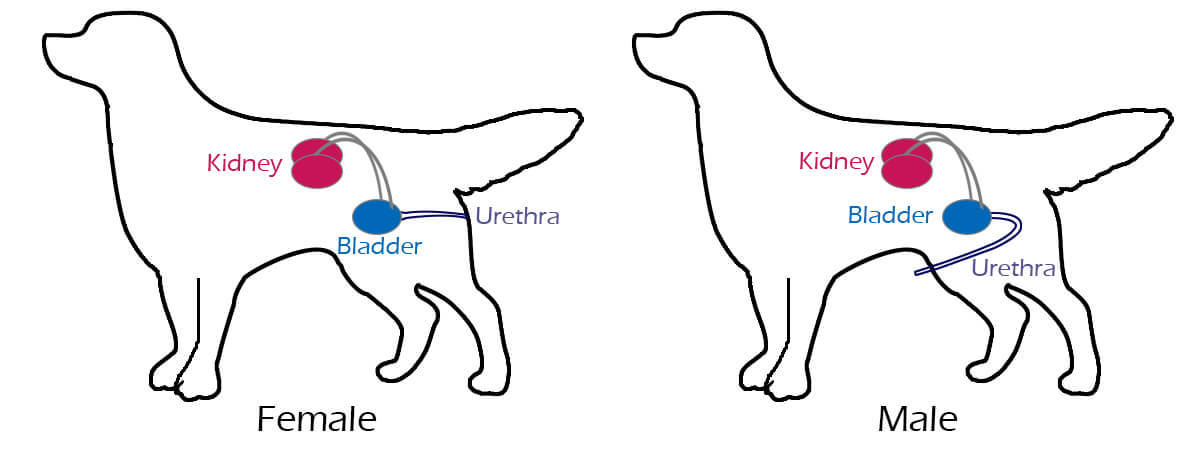
Option 1: Home remedy for Urinary Tract Infection: Cefalexin
This happened one night when my dog was 7 years old and I couldn’t get her to the vet at that time. I gave her Cefalexin tablets to control the infection (Cefalexin was prescribed to my dog for skin problems. So I know my dog isn’t allergic to Cefalexin, which is critical). After taking the medicine for about half an hour, my old dog gradually calmed down.
Here is the home remedy:
| Pet Medication | Alternative | |
| Medication | Rilexine | Cephalexin US Brand Name: Bio-Cef, Keflex, Panixine DisperDose. Canadian Brand Name: Novo-Lexin |
| Active Ingredients | Cephalexin | Cephalexin |
| Dosage | The recommended dose is 10 mg/lb (22 mg/kg) of dog’s body weight twice daily for 28 days. * Please ask your veterinarian for appropriate dosing. |
The same of Rilexine |
Antibiotics(Cephalexin) for Urinary Tract Infections in Dogs *
Data source: Virbac Rilixine product manual
I have also listed below the dosing table by dog’s weight for your refererence.
| Dog Body Weight (lbs.) | Cephalexin Dosage |
|---|---|
| 10 lbs | 100mg each time, 2 times a day |
| 10-20 lbs | 100-200 mg each time, 2 times a day |
| 20-30 lbs | 200-300 mg each time, 2 times a day |
| 30-40 lbs | 300-400 mg each time, 2 times a day |
| 40-50 lbs | 400-500 mg each time, 2 times a day |
| 50-60 lbs | 500-600 mg each time, 2 times a day |
| 60-70 lbs | 600-700 mg each time, 2 times a day |
| 70-80 lbs | 700-800 mg each time, 2 times a day |
| 80-90 lbs | 800-900 mg each time, 2 times a day |
| 90-130 lbs | 900-1300 mg each time, 2 times a day |
| Dog Body Weight (kg) | Cephalexin Dosage |
|---|---|
| 5kg | 110 mg each time, 2 times a day |
| 5-10kg | 110-220mg each time, 2 times a day |
| 10-15kg | 220-330mg each time, 2 times a day |
| 15-20kg | 330-440mg each time, 2 times a day |
| 20-30kg | 440-660mg each time, 2 times a day |
| 30-40kg | 660-880mg each time, 2 times a day |
| 40-60kg | 880-1320mg each time, 2 times a day |
Option 2: Home remedy for Urinary Tract Infection: Amoxicillin Clavulanate Potassium
Amoxicillin clavulanate potassium is another choice to treat urinary infection in dogs. (make sure your dog is not allergic to penicillin)
| Pet Medication | Alternative | |
| Medication | CLAVAMOX | Amoxicillin and Clavulanate Potassium US Brand Name: Amoclan, Augmentin, Augmentin ES-600, Augmentin XR Canadian Brand Name: Alti-Amoxi Clav, Apo-Amoxi Clav, Novo-Clavamoxin 125, Novo-Clavamoxin 250, Ratio-Amoxi Clav 250f |
| Active Ingredients | Amoxicillin and Clavulanate Potassium | Amoxicillin and Clavulanate Potassium |
| Dosage | The recommended dose is 6.25 mg/lb (12.5 mg/kg) of body weight twice a day. The maximum duration of treatment should not exceed 30 days.* | The same of CLAVAMOX |
* Data source: Zoetis CLAVAMOX product manual. US version. Canada version.
I have also listed below the dosing table by dog’s weight for your refererence.
| Dog Body Weight (lbs.) | Amoxicillin and Clavulanate Potassium Dosage |
|---|---|
| 10 lbs | 62.5mg each time, 2 times a day |
| 10-20 lbs | 62.5-125 mg each time, 2 times a day |
| 20-30 lbs | 125-187.5 mg each time, 2 times a day |
| 30-40 lbs | 187.5-250 mg each time, 2 times a day |
| 40-50 lbs | 250-312.5 mg each time, 2 times a day |
| 50-60 lbs | 312.5-375 mg each time, 2 times a day |
| 60-70 lbs | 375-437.5 mg each time, 2 times a day |
| 70-80 lbs | 437.5-500 mg each time, 2 times a day |
| 80-90 lbs | 500-562.5 mg each time, 2 times a day |
| 90-130 lbs | 562.5-812.5 mg each time, 2 times a day |
| Dog Body Weight (kg) | Amoxicillin and Clavulanate Potassium Dosage |
|---|---|
| 5 kg | 62.5 mg each time, 2 times a day |
| 5-10 kg | 62.5-125 mg each time, 2 times a day |
| 10-15 kg | 125-187.5 mg each time, 2 times a day |
| 15-20 kg | 187.5-250 mg each time, 2 times a day |
| 20-30 kg | 250-375 mg each time, 2 times a day |
| 30-40 kg | 375-500 mg each time, 2 times a day |
| 40-60 kg | 500-750 mg each time, 2 times a day |
Keep in mind that urinary tract infection may be associated with kidney disease or uterine effusion, a rapidly developing disease that can kill the dog in just a few days, will also show symptoms of urinary tract infection in unneutered female dogs. In case of emergency, home remedies are only used to control infection and relieve symptoms. Get your old pal to the vet for diagnosis and treatment as soon as possible is always the best choice.
Walking back and forth and licking mouth
It could be an oral disease. Please keep an eye on the dog if any of the following symptoms appear.
- The gums are red and swollen.
- Have bad breath.
- Severe dental calculi/tartar (yellow, tan or even black surface deposits).
If your dog experience any of the above symptoms, it is likely to be gingivitis. Gingivitis is reversible if seek medical treatment in time.
Furthermore, if the following symptoms appear, gingivitis may have progressed to periodontitis.
- Bleeding gums.
- Some teeth are loose.
- Saliva with blood.
- Blood stains were observed on water bowls or toys.
- Look for remote locations and demonstrate the act of hiding with trepidation (instinctively avoid showing weakness to potential predators).
It should be noted that periodontitis is irreversible and can result in bacterial infection of the heart.
Most adult dogs can tolerate mild even severe gingivitis, whereas older dogs, due to decreased immunity, may find it difficult to resist persistent periodontal redness and swelling or even be knocked down by severe periodontitis.
Home remedy for Gingivitis and Periodontitis
1. Thoroughly clean the periodontium with hydrogen peroxide. Wipe red and swollen gums and nearby teeth with a medical cotton swab or gauze dipped in 0.75-1% hydrogen peroxide (control the amount to prevent dogs from swallowing too much hydrogen peroxide, which can cause esophageal and gastrointestinal damage). Typically, the concentration of hydrogen peroxide sold is 3%, so use 1 part hydrogen peroxide and at least 2 parts water diluted to 1% or add 3 parts water to 0.75 %.
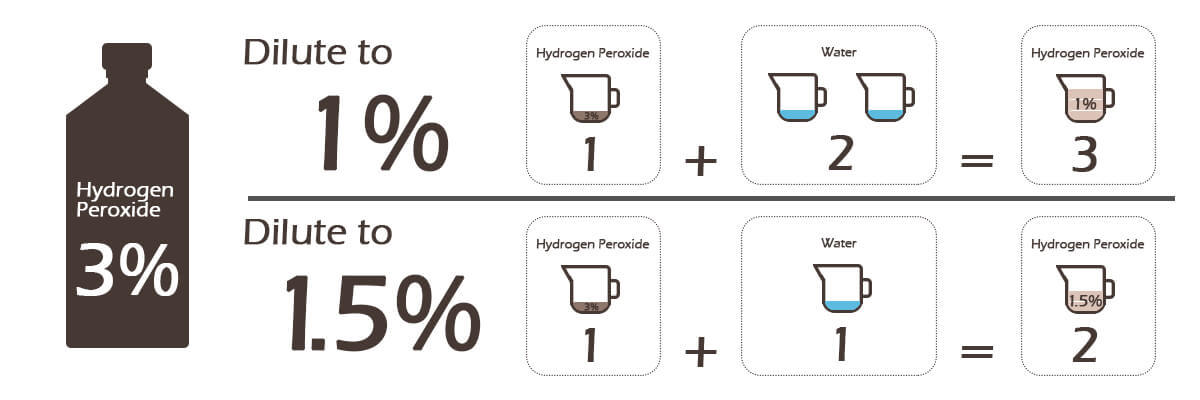
2. Wait about 10 minutes for the hydrogen peroxide to completely decompose and sterilize.
3. Relieve the pain. Apply aloe juice to the affected area after cleaning to help relieve the dog’s gum pain.
4. Antibiotics. I don’t recommend using antibiotics based solely on periodontal problems, periodontal cleaning is frequently sufficient if you just want the dog to sleep comfortably for the night and then go to the veterinarian the next day. However, if you encounter a difficult situation, such as being unable to visit the vet in next few days due to extreme weather, and the dog’s periodontal problem is becoming increasingly serious, then Clavamox(Amoxicillin and Clavulanate Potassium) can be your choice to help control the aggravation of the infection for emergency in the short term. (Do not give Amoxicillin and Clavulanate Potassium to your dog unless you make sure your dog is not allergic to penicillin)
Brushing your dog’s teeth with pet toothpaste every day is still the best long-term prevention and treatment. This will keep your dog away the anesthetic teeth cleaning for years. As you may be aware, dentists typically require x-rays and anesthetic to remove plaque and tartar. Senior dogs are at a much higher risk of not waking up under anesthesia than adult dogs, besides it is also an expensive procedure.
I brush my 8-year-old golden retriever’s teeth every night, let me show you how clean the teeth can be.
This photo was taken 29 months after the last tartar cleaning.
Walking back and forth and drooling too much
Please inspect for discolored dog teeth, such as pink, black, brown, or gray. If there is discoloration, it is most likely pulpitis. Pulpitis, usually caused by trauma or inflammation inside the tooth, can cause pain in dogs. Trauma can result from a blow or from chewing on too hard objects.
Home remedy for Pulpitis:
Antirobe Aquadrops(Clindamycin Hydrochloride), which treat severe infections caused by anaerobic bacteria, can be used to treat pulpitis.
| Pet Medication | Alternative | |
| Medication | Antirobe Aquadrops | Clindamycin Hydrochloride US brand: Cleocin HCl, Cleocin Pediatric Canadian brand: Dalacin C Palmitate |
| Active Ingredients | Clindamycin Hydrochloride | Clindamycin Hydrochloride |
| Dosage | 2.5-15.0 mg/lb or 5.5-33 mg/kg body weight every 12 hours* | The same of Antirobe Aquadrops |
* Data source: Zoetis Antirobe Aquadrops product manual
I have also listed below the dosing table by dog’s weight for your refererence.
| Dog Body Weight (lbs.) | Clindamycin Hydrochloride Dosage |
|---|---|
| 10 lbs | 25-150 mg every 12 hours |
| 20lbs | 50-300 mg every 12 hours |
| 30lbs | 75-450 mg every 12 hours |
| 40lbs | 100-600 mg every 12 hours |
| 50lbs | 125-750 mg every 12 hours |
| 60lbs | 150-900 mg every 12 hours |
| 70lbs | 175-1050 mg every 12 hours |
| 80lbs | 200-1200 mg every 12 hours |
| 90lbs | 225-1350 mg every 12 hours |
| 100lbs | 250-1500 mg every 12 hours |
| Dog Body Weight (kg) | Clindamycin Hydrochloride Dosage |
|---|---|
| 5 kg | 27.5-165 mg every 12 hours |
| 10 kg | 55-330 mg every 12 hours |
| 15 kg | 82.5-495 mg every 12 hours |
| 20 kg | 110-660 mg every 12 hours |
| 30 kg | 165-990 mg every 12 hours |
| 40 kg | 220-1320 mg every 12 hours |
| 50 kg | 275-1650 mg every 12 hours |
| 60 kg | 330-1980 mg every 12 hours |
Pulpitis can cause pain in dogs, but I don’t recommend giving dogs painkillers indiscriminately, as some painkillers tend to cause severe adverse reactions and even death in dogs. Getting to the vet for treatment as soon as possible is always the first choice.
Walking back and forth, excessive drooling, with swollen abdomen and arched back movements
It is most likely a GDV (Gastric Dilatation-Volvulus) if also showed the following symptoms:
- Shortness of breath.
- Vomiting accompanied by swallowing.
- When the disease is severe, the dog’s oral mucosa will turn pale, and the dog’s consciousness will be hazy, and even shock.
GDV (Gastric Dilatation-Volvulus), in layman’s terms, the dog’s stomach becomes a knotted bag, all the gas is trapped inside and cannot be excreted, and high gastric pressure prevents blood from flowing back from the hind legs and abdomen to the heart.
If you suspect your dog has GDV, try pressing his abdomen. If the dog screams in pain, it’s time to take him to the vet. You should not expect to cure your dog’s GDV at home. It’s a true emergency! Please take your dog to the vet within two hours.
GDV can affect any dog, while Danes, Irish wolfhounds, Irish setters, standard poodles, and German shepherds are at a higher risk than other breeds.
Walk back and forth, gnawing at paws or other parts of the body and making a loud noise in the mouth while doing so
- Rub against the wall.
- Scooting bottom on the ground
- Tickle restlessly.
For skin infections:
Please check the area shown in the picture for skin lesions, pimples, redness, rash, lumps and abnormal secretions.
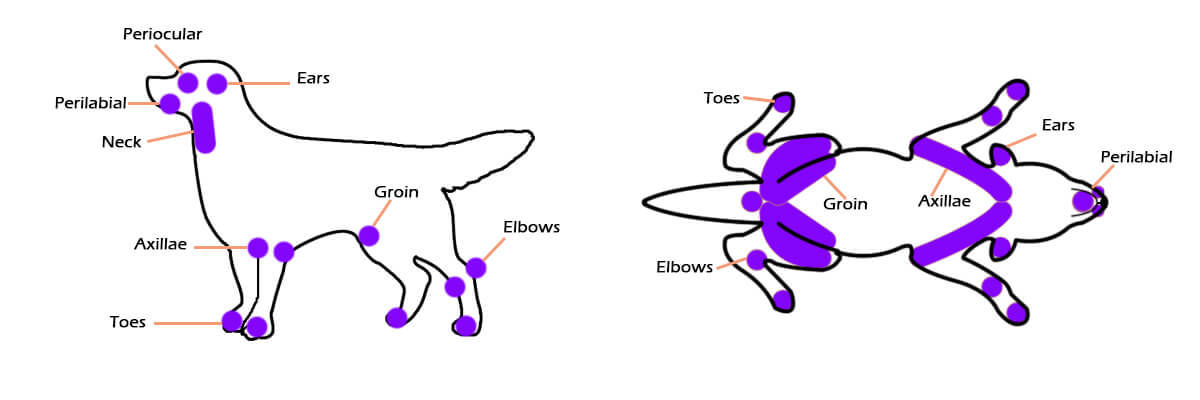
Home remedy for skin infection:
- If there is no skin lesion: Disinfect with iodophor and apply povidone-iodine topical ointment.
- If a large area of skin lesion with fluid continues to exudate: Use wound collagen powder to dry the skin lesion after iodophor wiping and disinfection, so that the wounds scab as soon as possible, and povidone-iodine topical ointment can be used to control infection after scab.
- In my experience, it takes longer to heal a wound with fluid oozing if you use povidone-iodine topical ointment directly without dry the wound first. The liquid is difficult to dry naturally, especially when wounds on the dog’s abdomen, where there are many skin folds, are more likely to suppurate and suffer secondary trauma.
- Simultaneously, oral Cefalexin administration is required to control infection.
- Always use an E-collar to keep the dog from licking or biting the affected area and worsening the infection.
For anal glands:
In addition to the most typical “scooting bottom on the ground”, it also shows the following symptoms:
- The dog smells like fish
- Licking/biting the anus repeatedly
Home remedy for anal glands:
Express the anal glands. Anal glands, with 2 drainage holes at 4:00 and 8:00 of the anus, can be expressed by finger squeezing. You’d better prepare the following items before squeezing:
- Disposable gloves to protect your hands
- Tissue/kleenex to absorb the fluid expressed
- Wet wipes to wipe up fluid dripping on hair, skin and ground
- Deodorizing sprays to eliminate odors remaining in the air and ground
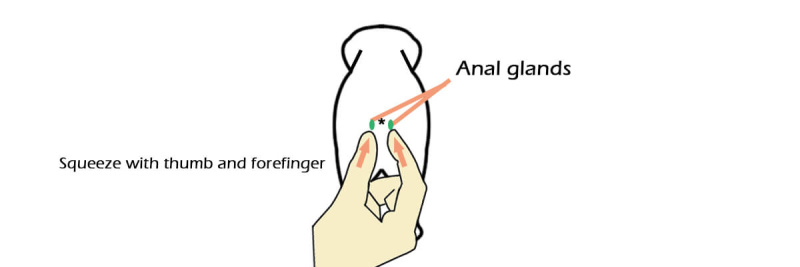
For tick bites:
Please refer to the picture below to check the high-risk areas of ticks
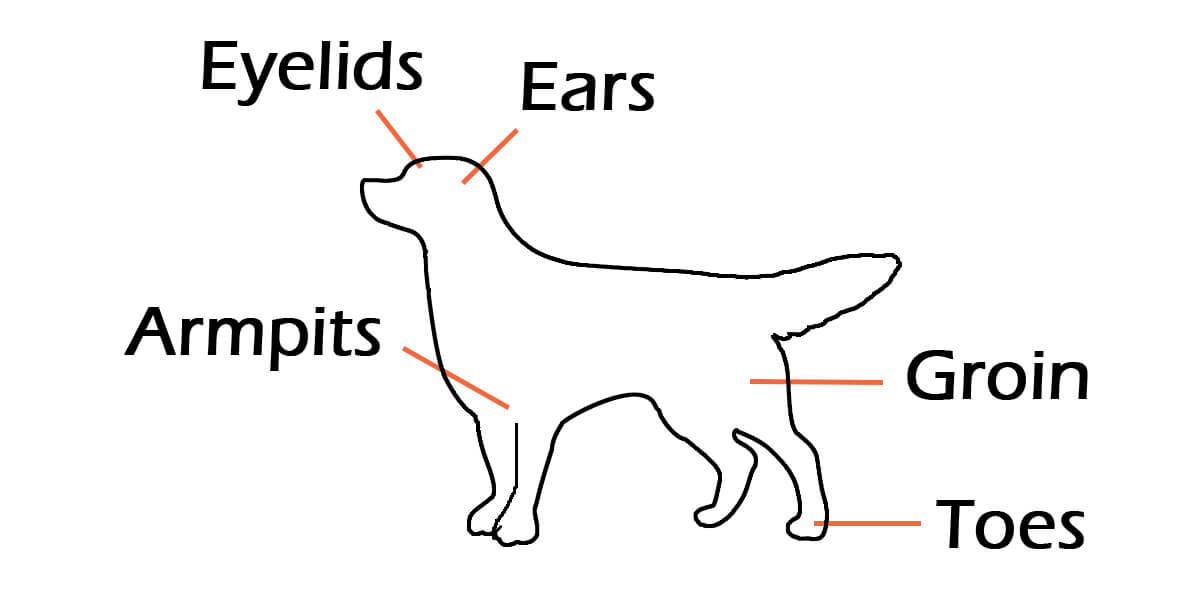
Home remedy for tick bites:
- Apply chloroform, ether, kerosene or turpentine to the head of the tick.
- After the tick suffocates, use tweezers to remove the tick.
- Do not pull out the tick with your hands to prevent secondary skin damage caused by tearing tissue or mouthparts broken.
- When pulling out ticks, the tick should be pulled up vertically with the skin to prevent tick mouthparts from falling in the body and causing local inflammation.
- If the mouthpiece is broken into the skin, it should be surgically removed by vet.
Walking back and forth, disorientation, peeing or stool in house
Walking back and forth, disorientation, peeing or stool in house is a sign of dog dementia, in addition, if your senior dog also exhibits the symptoms listed below, it is highly suspected that your dog has Dog Dementia(Canine Cognitive Dysfunction). (Refer to this blog post to learn more about “early signs of Canine Cognitive Dysfunction”.)
Here are the early signs of dog dementia:
- Sleep less and wake up frequently at night.
- Show anxiety or fear towards family members or other animals.
- Lack of interest in the approach, greeting or touching/petting.
Use the scoring system in this blog: Early signs of dementia in dogs to assess cognitive ability of your dog if you suspect your dog has CCD.
Home remedy for Dog Dementia:
- Fish oil rich in Omega 3 can slow down the development of CCD
- Appropriate amount of melatonin specific to dogs can help dogs with CCD sleep better at night (please do not feed dogs with human melatonin, which may contain some ingredients that are harmful or even fatal to dogs).
I have also listed below the dosing table by dog’s weight for your refererence.
| Dog Body Weight (lbs.) | Omega 3(Total EPA & DHA) Dosage (NRC* recommended allowance) |
Melatonin Dosage |
|---|---|---|
| Under 10 lbs | 165.8 mg per day | 1 mg per day (2 hours before bedtime) |
| 10-25 lbs | 165.8-414.5 mg per day | 1.5 mg per day (2 hours before bedtime) |
| 25-100 lbs | 414.5-1658 mg per day | 3 mg per day (2 hours before bedtime) |
| 100 lbs+ | 16.58mg per lbs per day | 3-6 mg per day (2 hours before bedtime) |
| Dog Body Weight (kg) | Omega 3(Total EPA & DHA) Dosage (NRC* recommended allowance) |
Melatonin Dosage |
|---|---|---|
| Under 5 kg | 150 mg per day | 1 mg per day (2 hours before bedtime) |
| 5-10 kg | 150-300 mg per day | 1.5 mg per day (2 hours before bedtime) |
| 10-45 kg | 300-1350 mg per day | 3 mg per day (2 hours before bedtime) |
| 45 kg+ | 30 mg per kg per day | 3-6 mg per day (2 hours before bedtime) |
*NRC: The National Research Council
Part II: Whining and crying at night: a sign of pain
If your older dog is only whining and crying and not walking back and forth, it is likely that he or she is in excruciating pain. The most figurative signs of pain are whining and crying, and the dog not getting up and moving often means that the dog has difficulty getting up and moving because of the pain or is reluctant to move due to the pain.
The most pain-sensitive dog breeds, according to veterinarians’ rank, are the Chihuahua, Dachshund, German Shepherd, Husky, Maltese, Pomeranian and Whippet. If your older dog is of these breeds, he or she will be the first to cry to tell you the pain.
According to veterinarians’ rank, the following dog breeds are the most tolerant of pain:
- Boxer
- Bulldog
- Golden Retriever
- Labrador Retrieve
- Mastiff
- Pitbull
- Rottweiler
When other breeds start crying, these breeds still greet their owners with a sweet smile while in the same level of pain.
Owners of the above dog breeds should pay closer attention to signs of pain in their dogs.
Main causes of pain
Pancreatitis, ear infection and arthritis can all cause pain in dogs, but only arthritis pain is difficult to detect because the other conditions have obvious symptoms other than pain, such as vomiting, odor, and so on.
Furthermore, arthritis is very common in older dogs, particularly in the following breeds:
- Bernese mountain dogs (hips and elbows)
- German Shepherd (spine, hips, elbows)
- Golden Retriever (hips)
- Labrador (hips and elbows)
- Springer Spaniel (hips and elbows)
- Rottweiler (hips and elbows)
If your dog is one of the breeds listed above, pay extra attention to its joint health. And I will give you more details on arthritis pain in the next paragraph.
Diagnosis of Arthritis
My golden retriever, who is eight years old, has CHD and arthritis. The following symptoms can be used to determine whether a dog has arthritis based on my observations and a summary of my dog’s daily behavior:
- When changing from a prone to a standing position, it appears reluctantly or laboriously, often accompanied by a sigh or breathless sound.
- Reluctance to climb and descend stairs. When it is time to go up and down the stairs, the dog will stand in a daze in front of them, indicating that it must muster the courage to endure joint pain in order to do so.
- When go upstairs, the dog tends to lean against the wall with one side of their body. This could be due to the need to lean against the wall for additional support or to allow the back foot on one side of the body to lean against the wall to prevent the weak back foot from sliding off the steps.
- The dog tends to sit and rest after walking for more than 10 minutes and is reluctant to get up and walk again.
The list above is only a summary of some notable symptoms based on my dog’s daily behavior and does not represent an exhaustive list of all arthritis symptoms.
Home remedies for arthritis
- Glucosamine Hydrochloride and Sodium Chondroitin Sulfate are proven safe ingredients that can quickly relieve dog joint pain. The following is a summary of the dosages found in dog joint supplements on the market:
- Another supplement that helps dogs with arthritis is omega-3-rich fish oil. Although fish oil does not relieve pain immediately, long-term use of fish oil in dogs can delay the progression of joint disease. Furthermore, fish oil has been shown to delay the development of Canine Cognitive Dysfunction (CCD) in dogs (refer to this blog post for more information about CCD).
- Infrared light therapy or hot compress therapy. Infrared lights and heat packs work by applying heat to the arthritic area, which increases blood circulation and cellular activity, allowing the dog’s body to recover from inflammation faster. Supplements provide medicinal support for dogs, whereas infrared therapy or thermal compress therapy stimulates the vitality of the dog’s body to fight inflammation. (Please refer to this blog post for more information on infrared physiotherapy and hot compress physiotherapy for dogs.)

